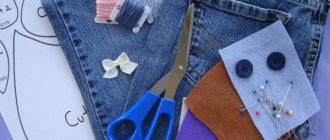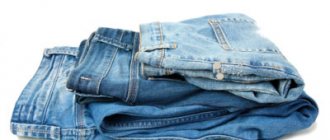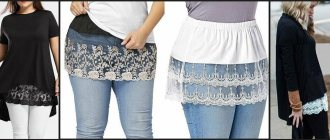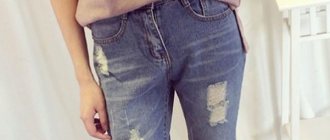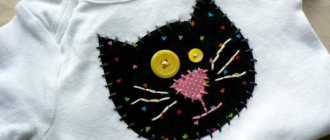Jeans is a material that is made from thick cotton. After unsuccessful washing, it may change in size. If this happened to your favorite denim trousers or you bought clothes that didn’t fit your child, then it’s too early to despair. There are several ways to lengthen jeans with your own hands at home. You will need standard sewing tools, a little effort and free time.
Lengthening jeans at home
A situation often arises: jeans are good for everyone, just add some length! This happens to children and teenagers all the time, and some men's or women's trousers become shorter after washing. You should not immediately put the item aside as unusable. Jeans can be lengthened. We'll tell you how to do this at home.
Preliminary stage
You need to prepare for work by checking that you have everything you need. In addition to a sewing machine (and an overlocker if possible), when lengthening jeans you will need:
- Needles of different sizes and pins for basting and joining materials.
- Matching thread color and quality.
- Scissors.
- The material for marking fabric is chalk or a small piece of soap.
- Measuring tools: measuring tape, ruler, square.
- Material for lengthening (denim, lace, cotton, etc.) and for processing (trouser tape).
Choosing a way to do the job
You need to think about the option of lengthening your jeans in advance. You can add the necessary centimeters to your pants using another material: in the form of inserts into the main fabric or cuffs. The trousers will become a little longer if you reduce the size of the hem at the bottom of the legs. Each method has its own characteristics.
Necessary materials
Before starting the process, you should prepare materials. To change the length you will need:
- scissors;
- a stationery knife, seam ripper or nail scissors;
- threads with a similar shade of material or finishing stitch;
- sewing machine or needles for hand sewing; for knitwear and elastic products, it is preferable to choose an overlocker;
- centimeter and ruler;
- soap or chalk;
- fabric scraps, trouser braid for men's products (if it is not included in the model), decorative braid or lace for girls;
- iron, piece of gauze;
- knitted fabric for sports pants; elastic material can be used as cuffs.
Basic ways to lengthen jeans
Changing a Hem Seam
The easiest way is to keep the hem to a minimum.
Operating procedure:
- It is necessary to open the seam that secures the hem. The work is done from the wrong side, carefully cutting the threads without damaging the material.
- Threads are removed from the front and back sides of the trousers.
- The lapel is straightened, the fabric is carefully ironed, if necessary, using steam, trying to ensure that the mark from the lapel ceases to remain noticeable.
- The new length of the jeans is applied to the fabric with chalk or soap.
- The cut of the material is processed. To do this, you can make a special seam or sew on a trouser braid.
- The processed bottom of the trouser leg is folded to the intended length, and the resized hem is sewn on.
Advice! The threads should be cut using small scissors with sharp ends. Nail scissors are best suited for this.
Important! The braid is not sewn directly to the cut of the trouser leg. It is secured with the same fabric so that about 5 mm remains from the cut of the trousers to the braid.
Insert from another material
The panels lengthen the pants, adding more centimeters than the cuff. This work is more painstaking and requires suitable material. You can use lace or even multi-colored cotton fabric as inserts.
Operating procedure:
- The side seam of the trouser leg is ripped out.
- A line of inserts is outlined on the jeans.
Advice! It is more advisable to make inserts in the lower part of the trouser leg (below the knee), which stretches less in width during use.
- The pant leg is carefully cut to add the insert.
- An insert of the required size is cut from the additional material. The width should match the width of the opened trouser leg.
- The insert is sewn to each part of the leg, below and above the slit. The edges of the seams are processed.
- After ironing the trouser leg, a side seam is sewn.
- The same work is done on the second leg.
Cuff
Using an insert at the bottom of the trousers, you can not only lengthen them, but also add an additional finishing element to the trousers - a cuff. This will give your usual pants a new look.
The work can be done in several ways.
Method 1 - lace cuff
This option requires minimal action and does not require ripping out existing seams.
Operating procedure:
- The width of the bottom edge of the trouser leg is carefully measured.
- A suitable piece is cut from lace of a suitable height. It must exceed the measured width taking into account the seam allowance (1 - 1.3 cm).
- A side seam is made on the lace fabric.
- The lace is sewn to the bottom of the trouser leg. This work can be done manually. If the length allows, the hem is not ripped off in this case. If necessary, the hem is torn off, the lace is sewn to the denim with a machine seam, and the fabric cut is processed.
- Carefully iron the trouser legs so as not to damage the lace.
Method 2 - fabric cuff
You can also make a cuff from a fabric of suitable color and quality.
Operating procedure:
- The bottom edge of the trouser leg is measured.
- A rectangle is cut out of the selected fabric - the future cuff.
Advice! The cuff pattern should be 2.5 cm wider than the trouser leg (for stitching). The recommended cuff height is 6.5 – 7 cm.
- The hem of the jeans is peeled off, the threads are removed, and the fabric is ironed.
- A side seam is made on the cuff, and the fabric cut is processed.
- The top edge of the cuff is connected to the bottom edge of the pant leg. The work is done first with pins, then a basting seam is made, after fitting - machine stitching and processing of the fabric.
- At the bottom of the cuff, the fabric is reinforced with interlining or a special edging and a hem is made.
- The trouser leg is ironed, similar actions are performed on the second trouser leg.
Some are shorter, some are longer...
Trouble with short trousers can occur not only in the case of unsuccessful sewing experiments. Denim fabric tends to shrink, the owner of the pants can simply grow up, it happens that jeans that fit perfectly in the waistband and are practically unworn lose their appearance only in the lower part, then you have to cut off the disheveled legs and think about how to lengthen the jeans to give them second life.
When clients bring trousers to a professional studio, the master must carefully try them on; it is important to initially take with you the shoes in which you plan to wear the hemmed jeans. These precautions will help you avoid troubles with “shot” pants and wasted money.
When picking up the finished work from the seamstress, many clients often wonder why they are given small pieces of cut-off pants along with the finished trousers. The fact is that sewing workshop employees more often than others have to face the question of how to lengthen jeans. They wisely give the cut pieces to their clients so that, if necessary, they can come back for subsequent trouser repairs with the finished material. A seamstress can make cuffs, a lapel out of this nondescript piece, or simply sharpen it to the trouser legs. Such repairs will not take much time and will not require careful selection of fabric, because it is not always possible to select the material of the desired thickness, color or texture.
Features of lengthening jeans for men
The most suitable way to lengthen men's jeans is to sew on a cuff made of a different material.
Not many representatives of the stronger sex consider it appropriate to use lace or bright fabric with a floral print, which is acceptable when working with children's trousers. Also, teenagers and young people who want to look unusually stylish at the same time do not refuse such cuffs.
For more reserved men, a companion fabric that matches the quality and texture of the fabric would be more appropriate. The cuff can also be contrasting in color; a cuff made of checkered or striped fabric looks original.
Features of lengthening jeans for children
Lengthening jeans for children is a good way to extend the use of items that have not yet worn out, remain durable and comfortable. When working with children's things, you can give complete freedom to creativity and imagination. You can transform pants for babies using all available methods: inserts, cuffs, reducing hems. Any bright fabric, floral or polka dot prints are allowed.
Advice! When choosing a material, avoid using knitwear, which does not stretch the same as denim. Be sure to ensure that the cotton fabric you choose is fade-resistant.
The main peculiarity of working with children's jeans is the correct choice of place for the inserts. It should not coincide with the pockets, so it is easiest to work along the bottom line of the pants.
Another way to lengthen children's jeans is to change the waistband. It needs to be torn off, straightened and smoothed out. To make the belt larger, the entire denim fabric is made with the right side, and for the back, another part of the same size is cut out. The wrong part is applied from the front side, sewn on the sides and top, and turned inside out. Now the back of the belt has a different look. The new belt is sewn to the trousers, and the cuts are processed.
Lengthening jeans without sewing
Jeans are lengthened not only by alterations. You can stretch your trousers to length using water and a soap solution. This method will not add additional centimeters to the pants, but will return them to their original length if the pants “shrink” after washing.
To stretch the fabric we will use a soap solution.
Advice! To achieve results and a gentle effect on denim, it is best to use shampoo for children.
Operating procedure
- A large container (baby bath, bathtub, large, etc.) is filled with warm water and baby shampoo (1 cap) is added.
- Jeans are completely immersed in water and left in it for at least 0.5 hours.
- After this, the pants are taken out of the container and wait a while for the water to drain. There is no need to squeeze!
- Remaining moisture is removed by rolling the jeans in a large terry towel. The pants are rolled up with a tight roller along the length of the legs, pressing on them so that the water is absorbed into the towel. The procedure is repeated several times, replacing the wet towel with a dry one.
- The remaining wet jeans are laid out freely on dry terry cloth - a sheet or towel. Methodically, carefully, but they stretch the legs. The work is done gradually, along the entire length, starting from the waistline, moving down.
- Having stretched the material as much as possible, proceed to drying. Jeans are dried by hanging vertically.
How to lengthen jeans after washing
Shrinkage after washing is one of the most common problems with denim material. However, you can correct the situation in a simple and quite effective way, without resorting to cutting and sewing. To do this, put on jeans after washing them in a wet state and wear them for a while, do squats and bends. The result is obvious - women's trousers become longer immediately. The problem is that putting on a wet item is quite difficult. Therefore, it is better to stretch them dry and then spray them with water. Particular care should be taken to wet those areas that are tight. In this way, you can not only lengthen it a little, but also stretch the fabric in those places that compress the body. It is necessary to use warm water for wetting, and cool water during pre-washing.
You can also stretch denim pants a little if you wash them as quickly as possible without using aggressive products and without using the drying mode. The slightly damp product is steamed with an iron and, at the same time, ironed through gauze, stretching it in the right places with your hands. You can lengthen wet jeans after washing if two people pull the legs in different directions. During the drying process, repeat the procedure several times.
Important! This method can only be used for materials that contain denim, cotton and a little elastane. If there are synthetic fibers, it will be difficult to stretch jeans.
Tips for lengthening jeans at home
- Carry out work on lengthening jeans on a clean product, after pre-washing.
- Carefully select materials for inserts, sew them carefully and carefully. Make sure that the new fabric does not tighten the base.
- Experienced craftswomen prefer light fabrics: sewing heavy material to jeans is more difficult.
- It is better to stretch wet jeans that do not have torn parts. Existing tension holes can look untidy and unattractive.
- Be careful when stretching the fabric near appliques, embroidery or rhinestones.
Take your time, be patient and careful - and the result of the work will please you and your loved ones!
How to stretch jeans
Mom Jeans
Reviews
Svetlana
Five years ago, I unsuccessfully washed my favorite jeans in the machine. After that they sat down and were short. The stretching method was ideal. But, I pulled them out not on the sheet, but on myself. She put on her slightly damp jeans and pulled them down until they became longer. Then I dried it. Fortunately, this helped me get my previous length back.
Victoria
A few years ago, my daughter’s jeans became too small. It was a pity to throw them away, since they were her favorite ones. I decided to lengthen them using fabric inserts. First I took cotton fabric and sewed it on, but it quickly stretched and began to look ugly. Replaced it with denser material. The result was excellent, my daughter wore them until they became too small for her again.
Subscribe to our channel in Yandex.Zen! Click “Subscribe to channel” to read Hozsekretiki.ru in the Yandex feed
